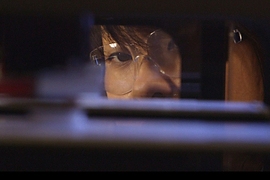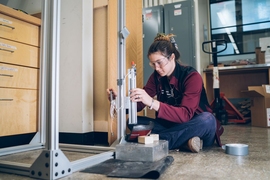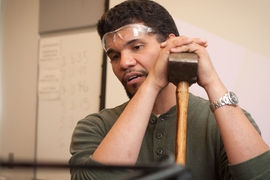A sign above the door says it all: MakerLodge. Here MIT students build things: a four-legged robot, a zoetrope, a gumball machine, an alpha particle spark detector. In fact, a group of them helped build the makerspace itself this summer.
MIT’s "Maker Czar" Martin Culpepper says the students, known as MakerLodge mentors, are at the core of any successful makerspace. The key, adds Culpepper, is for safety-minded and skilled students to help build not just the space, but a community.
Now the students have lit up the welcome sign, wired the space for sound, and await the key ingredient: the freshmen. As of Sept. 12, first-year students can sign up to participate in MakerLodge, a grassroots-inspired training program designed to draw them into the making community from the get-go.
On a recent afternoon, Culpepper walked around, greeted students, and showed off a widget that freshmen can make as part of the training program. It’s a hand-held edge-lit sign with planetary gear on the back end. The lettering reads: MakerLodge. Students can personalize it with their names, too.
The sign is the marker of their graduation from the training process, wherein students learn to use introductory maker technology. “This provides freshmen with the intro-level training that helps them prepare to use other spaces on campus,” says Culpepper, who is also a professor of mechanical engineering, and runs the MakerLodge program via MIT’s Project Manus.
Areas covered in the MakerLodge basic training include: safety training, 3-D printing, laser cutting, and hand tools. Advanced training, starting later in the fall, will include programming, CNC machining, soldering, sewing, and drill presses and bandsaws.
The energy of the MakerLodge, a blanket label for three rooms in Building 35, is relaxed and engaging. The main room has a large block island of workbenches in the center and seven 3-D printers lining one wall, two laser cutters by the windows, and a ShopBot in the corner. About half the room is filled with workbenches and equipment like belt sanders and hand tools. Most of the training will occur here.
There are two additional rooms down the hall. In one, a half dozen students are eating takeout food in the student mentor lounge, the area where the student volunteers prepare for training and relax. Several are sitting on a couch with their feet up, engaged in discussion. This is a good thing, says Culpepper.
“Successful makerspaces rely on areas to support community, social interaction, and cross-pollination of ideas,” he says. “In any makerspace the most used, highest-impact piece of equipment is the couch. I’m serious.”
A smaller room is filled with sewing machines. Culpepper says students can also learn to sew, if desired. Many of the undergraduate volunteers did so this summer, by making shorts. There is also a vinyl cutter for the mentors.
“I plan to come by and make a decal for my Ducati Monster,” says Culpepper. This captures the vibe well — the MakerLodge is a place where you can find an MIT tenured professor hanging out with students, making a decal for his motorcycle.
About 20 student volunteers — mentors — worked over the summer to create the space, the training program and learn how to run safe and effective training. Soon they will guide small groups of freshmen through a four-hour training delivered over two sessions. Culpepper is seeking 20 additional student mentors. In return for their service, volunteers get 24/7 access to the makerspace.
Junior Ruben Peinado, a student volunteer and mechanical engineering major, is making the most of the MakerLodge. He used the ShopBot to make a beautiful skateboard. He precisely cut the board profile and styled it with his own design. With the laser cutter, he engraved the bottom of the board with a complex picture that would have taken hours to do by hand. He used the sander to smooth the edges of the board for a better grasp while riding.
Back in the main room at the MakerLodge, Culpepper points to the imprint of a skateboard on the ShopBot. Peinado intended to cut out the shape but the depth input was too deep, and he cut into protective sacrificial wood between the work surface and the table bed.
“This is from the second one,” says Culpepper with a smile. “The first skateboard ended up at the bottom of the Charles [River]. All I’ll say is it kind of got away from him.”
Peinado says he was riding back to his fraternity house, across the Mass. Ave. Bridge, and lost his footing on the skateboard. “I kind of walked off before I fell on the sidewalk,” he says. “Unfortunately, my board still had a lot of speed.” Before he realized what was happening, it was halfway under the bridge rail. Then it plummeted into the river.
The loss was sobering for him as a maker. He recognized too late that he “messed up” some of the finer details, such as the positioning of the wheels. “That board ended up at the bottom of the river because I made mistakes with how I made it.” Now he is focused on his next model, which he intends to make motorized.











